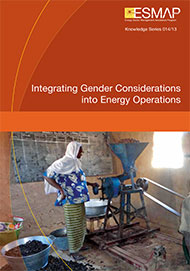Gender | Social Inclusion in the Energy Sector | Publications
Substantial analysis is needed to build frameworks for adopting a gender-sensitive approach. This includes stocktaking of the gender dimensions and actions on the ground within the energy sector, as well as identifying strategic entry points and resources for mobilizing efforts.
Building off the regional and thematic interventions, ESMAP has distilled lessons learned and identified good practices to share this knowledge at a local and global level. Knowledge sharing and outreach is integrated throughout the technical assistance work of just-in-time assistance and capacity building efforts.
|
Featured Publications
|
 |
Integrating Gender Considerations into Energy Operations
As highlighted in the World Development Report (WDR) 2012, gender equality is critical in order to fully realize the potential development impacts of World Bank programs across all sectors. Towards this goal, the World Bank has scaled up gender mainstreaming as a corporate priority, with a particular focus on the WDR’s framework.
The objective of this briefing note is to provide World Bank energy task teams a brief overview of the key issues, resources and tools to help integrate gender considerations into energy sector operations.
|
|
|
Expanding Women's Role in Africa's Modern Off-Grid Lighting Market
The annual spending for fuel based lighting worldwide approaches US$40 billion, and a growing range of modern lighting products that incorporate innovative designs and business models are gaining market share.
On the household level, women stand to benefit greatly from better lighting and energy access. Entrepreneurial women have a stake as well; modern lighting and communications technology enables them to strengthen their enterprises. The Expanding Women's Role in Africa's Modern Off-Grid Lighting Market report focuses on women’s role in the expanding market for modern off-grid lighting. In the context of access to energy and lighting, the aim of this work is to identify whether there are any women-specific opportunities in the offgrid lighting market that could enhance product profitability while also improving lives.
|
|
|
Mainstreaming Gender into Extractive Industries Projects | Guidance Note for Task Team Leaders
Extractive industries (EI) can bring many positive development impacts to the communities involved, but also have the potential to create or exacerbate vulnerabilities within these communities. Despite the ample evidence of gender bias—and its implications—in EI, there is significant scope for increasing the gender focus of most EI projects in the World Bank. The following guidelines briefly outline some of the ways that EI can impact men and women differently and the associated development implications, and provide step by step suggestions for how to understand and integrate gender issues into World Bank Group EI project design.
|
|
|
Gender Dimensions of the Extractive Industries | Mining for Equity
The extractive industries represent a major source of wealth in economies around the world, and women—with their formal and informal contributions—make up a tremendous component of the world’s workforce. Where women are not able to fully participate in the extractive industries, nor able to garner the full extent of compensation for the work that they do, it is not only women who suffer, but also the families, communities, and countries involved, as well as the extractive industries companies themselves. This report seeks to highlight the ways in which women are included in this increasingly important sector, in their participation in the sector itself, and in their ability to benefit from the labor they contribute.
|
|
|
Gender-Sensitive Approaches for the Extractive Industry in Peru | Improving the Impact on Women in Poverty and Their Families
This book presents the results of the study “New Approaches for Improving the Development Outcomes of the Extractive Industry in Peru: Improving Impacts on Women in Poverty and Their Families.” The study is a joint product of the World Bank’s Oil, Gas, and Mining Unit (SEGOM), the Energy Sector Management Assistance Program, and the World Bank Gender Action Plan.
|
|
Useful Resources and Literature on Energy and Gender
|
|
Organizations, Networks, and Initiatives on Energy and Gender
|